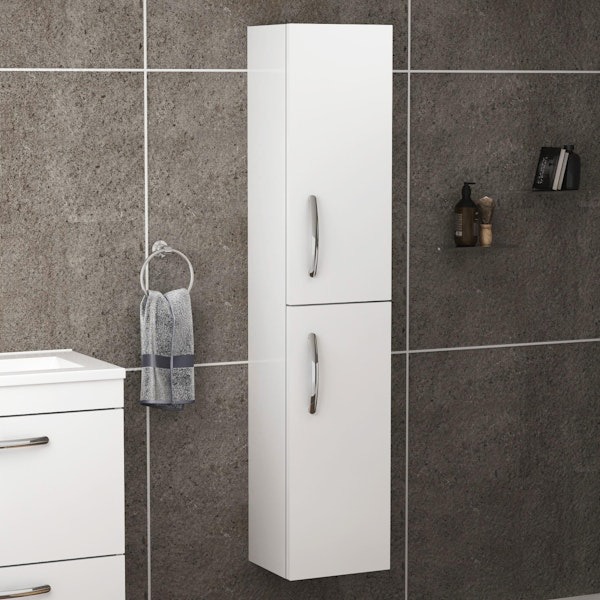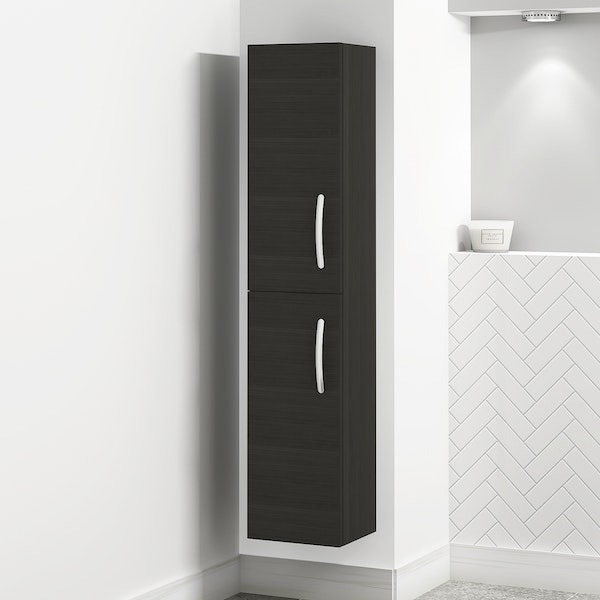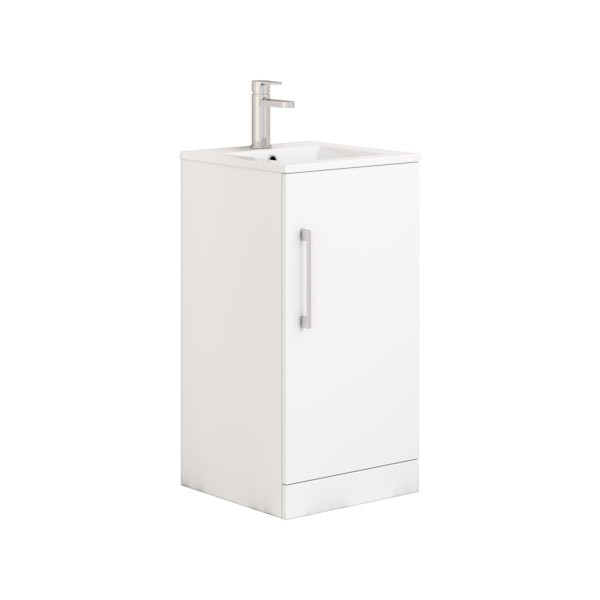
Installing a bathroom cabinet is more than just adding storage space; it can greatly enhance the visual appeal of your bathroom. Whether you're renovating or upgrading, achieving a perfect installation is essential for both functionality and aesthetics.
In this DIY installation guide, we provide easy-to-follow, step-by-step instructions to help you successfully install your bathroom cabinet.
Benefits of Installing a Bathroom Cabinet:
- Increased Storage Space: A bathroom cabinet provides valuable storage space for essentials, helping you keep your bathroom organised and clutter-free.
- Improved Functionality: A properly fitted bathroom cabinet provides you easy access to everyday items making your morning routine more efficient and enjoyable.
- Enhanced Aesthetics: The right bathroom cabinet can take your bathroom aesthetics to the next level. Whether you prefer a sleek and modern design or a classic and timeless style, a well-chosen cabinet can complement your decor and tie the room together.
- Counter Space Optimization: Installing bathroom cabinets frees up valuable countertop space and allows you to enjoy a cleaner and less cluttered surface.
- Protection and Privacy: A bathroom cabinet protects your essential items from moisture, dust, and potential damage. What’s more, if you share your bathroom with others, a cabinet can offer privacy to keep an item that you may not want to be openly displayed.
- Cost Saving: Bathroom cabinets are available in various shapes, sizes, and materials and are inexpensive to enhance bathroom storage.


Choosing the Right Bathroom Cabinet:
Assessing your Bathroom Space and Storage Needs
You should firstly assess your bathroom space and storage needs to select the cabinet that suits your requirements. Measure the area where you want to fit the cabinet, taking note of any obstructions like sinks, toilets, or doors.
Think about the items you plan to store, such as toiletries, towels, cleaning supplies, and personal belongings. Note the quantity and sizes of these items to determine the necessary number of shelves, drawers, or compartments you will need.
Types of Bathroom Cabinets and their Features:
- Wall-mounted cabinets are attached to the wall, providing storage space above the bathroom sink or vanity.
- Freestanding cabinets stand directly on the floor and can be placed anywhere in the bathroom.
- Medicine cabinets are typically installed above the bathroom sink and are designed specifically for storing medications, toiletries, and other small items.
- Tallboy bathroom cabinets are taller, narrow cabinets designed to store towels, linens, and other bathroom essentials.
- Under-sink cabinets fit underneath the bathroom sink and provide storage for cleaning supplies, extra toiletries, and other items.
- Open shelving provides a more minimalist and accessible storage option.
- Vanity cabinets are integrated with bathroom vanities and provide storage space below the sink.
- Corner cabinets are designed to fit into bathroom corners, utilising space that would otherwise be unused.
- Over-the-toilet cabinets are specifically designed to fit over the toilet, utilising vertical space for storage.


Preparing for Installation:
Necessary tools and materials:
Tools:
- Measuring tape
- Level
- Screwdriver (both Phillips and flathead)
- Drill
- Drill bits
- Pencil
- Stud finder
- Adjustable wrench
- Utility knife
- Hammer
- Safety goggles
- Clamps (if needed)
Materials:
- Bathroom cabinet (pre-assembled or DIY kit)
- Mounting brackets or wall-mounting hardware
- Screws and anchors
- Wood shims (if necessary for levelling)
- Wood putty or filler (for any gaps or holes)
- Sandpaper
- Finishing nails (if applicable)
- Wood glue (if applicable)
- Paint or stain (if desired for finishing)
- Cabinet knobs or handles (if not included with the cabinet)
- Optional: Mounting template (for precise installation)
- Optional: Caulk (for sealing any gaps between the cabinet and wall)
Marking and Measuring the Installation Area:
You should begin by marking and measuring the installation area to start the installation process. Use the measuring tape to determine the width, height, and depth of the cabinet, and mark these measurements on the wall with a lead pencil.
Step by Step Guide to Installing a Bathroom Cabinet:
Assembling the Cabinet (If Required)
Bathroom cabinets from Royal Bathrooms are supplied fully assembled, saving you time and hassle fitting them together. However, if you have ordered from somewhere else, you will first need to assemble the cabinet.
You should begin by gathering all the components and hardware provided with the cabinet and follow the step-by-step processes outlined in the manufacturer's manual.
Attaching the Mounting Hardware:
Follow the manufacturer's instructions to position the hardware on the back of the cabinet, aligning it with the predetermined markings on the wall or studs. Mark the locations for screw holes on the cabinet and use a drill with the appropriate bit to create pilot holes.
Securing the Cabinet to the Wall
Insert the appropriate mounting screws through the pre-drilled pilot holes and into the studs or wall anchors. Use a screwdriver or drill to tighten the screws until the cabinet is securely fastened to the wall. Be careful not to overtighten, as it can damage the cabinet or the wall.
Adjusting Doors and Shelves (if Necessary)
Properly adjusting the doors and shelves of a bathroom cabinet after installation is crucial for optimal functionality. While Royal Bathrooms pre-adjusts its cabinets, you may still need to make additional adjustments to suit your specific requirements.
Start by assessing the cabinet for any misalignments or gaps that need attention. Use the adjustable hinges to make small, precise changes to the door position, adjusting vertically, horizontally, and in-depth as needed.


Styling and Organising Your New Bathroom Cabinet
Tips for Organising and Maximising Bathroom Storage Space:
- Declutter and remove unnecessary items.
- Use storage bins or dividers to keep similar items together and easily accessible.
- Install hooks or adhesive organisers inside the cabinet doors for hanging items like hair dryers or towels.
- Utilise stackable or tiered shelves to create additional levels and maximise vertical space.
- Use unused space by using storage baskets or bins to neatly store smaller or infrequently used items.
Incorporating the Cabinet into your Bathroom Design:
Here are a few tips for incorporating the cabinet into your bathroom design.
- Choose a cabinet style that complements your bathroom's overall aesthetic.
- Coordinate the colour or finish of the cabinet with the existing colour scheme.
- Select a cabinet size that fits well within the available space.
- Consider the proportions to maintain balance in the bathroom.
- Opt for a cabinet installation with functional features that suit your needs.
- Add personalised touches with decorative knobs, handles, or open shelves.
Post-Installation Care and Maintenance:
Cleaning and Maintaining your Bathroom Cabinet:
Here are a few cleaning and maintenance tips to help you keep your new cabinet looking its very best for years to come.
- Clean regularly with a mild, non-abrasive cleaner and a soft cloth or sponge.
- Carefully clean handles and hardware with a gentle cleaner or mild soap and water, drying thoroughly afterwards.
- Immediately clean up spills or splatters to prevent staining or damage.
- Dust regularly using a microfiber cloth or soft brush.
- Ensure proper bathroom ventilation to prevent excessive moisture build-up.
- Use a waterproof liner or shelf liner to protect against water damage.
- Consider using a dehumidifier to regulate humidity levels in the bathroom.
- Regularly check for leaks or water damage and address any issues promptly.


Periodically Checking for any Needed Adjustments or Repairs:
Here are a few key steps to periodically check your cabinet for adjustments for repairs:
- Inspect the cabinet doors for proper alignment, secure closing, and smooth opening. Adjust hinges as needed.
- Test the drawers to ensure they slide smoothly without sticking or wobbling. Adjust drawer glides or tracks if necessary.
- Examine the shelves for sturdiness and levelness. Make adjustments to brackets or supports for stability.
- Look for signs of damage, such as water damage, warping, or peeling. Address issues promptly to prevent further damage.
- Tighten any loose screws or hardware like handles or knobs to ensure they are securely attached.
- Use appropriate cleaning products and methods to regularly clean the cabinet surfaces, inside and out.


Conclusion
Installing a bathroom cabinet on your own can be a rewarding DIY project which is achievable over a weekend.
Be sure to follow our step-by-step installation process, which includes measuring, preparation, assembly, and secure installation.
Consider the layout and plumbing of your bathroom and use the appropriate tools. Adjust the doors and shelves as needed to seamlessly integrate the cabinet into your bathroom design.
Don’t forget, regular cleaning and maintenance will ensure your cabinet's longevity.
Now all that’s left to do is kick back and enjoy your new bathroom cabinet and all its benefits!
